The Eight Extraordinary Meridians are a category of the body’s meridian pathways. They include the Du Mai (Governing Vessel), Ren Mai (Conception Vessel), Chong Mai (Penetrating Vessel), Dai Mai (Belt Vessel), Yang Wei Mai (Yang Linking Vessel), Yin Wei Mai (Yin Linking Vessel), Yin Qiao Mai (Yin Heel Vessel), and Yang Qiao Mai (Yang Heel Vessel). Unlike the twelve regular meridians, they do not directly connect to the organs and do not have a paired relationship, hence they are referred to as “extraordinary meridians”.
What are the Eight Extraordinary Meridians?
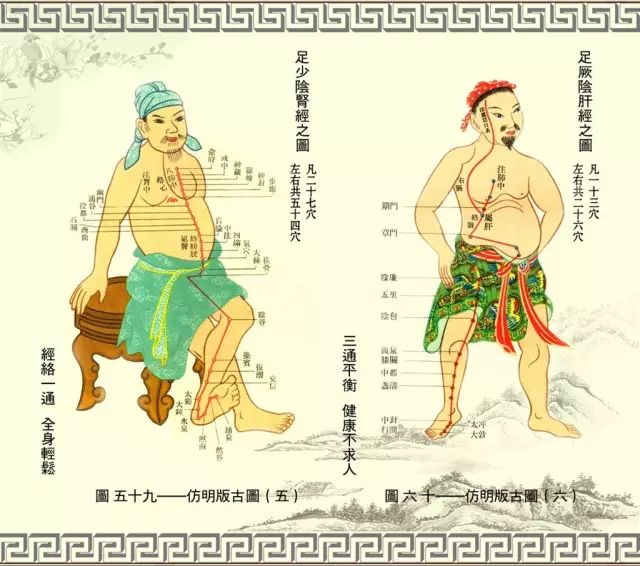
1Extraordinary Meridians
The Eight Extraordinary Meridians consist of the Ren Mai, Du Mai, Chong Mai, Dai Mai, Yin Qiao Mai, Yang Qiao Mai, Yin Wei Mai, and Yang Wei Mai. They differ from the twelve regular meridians as they do not directly connect to the organs and do not have a paired relationship, thus their pathways are unique.
Functions:
1. Facilitate communication between the twelve meridians;
2. Regulate the accumulation and distribution of qi and blood in the twelve meridians.
2Eight Meridians
1.Ren Mai: Runs along the midline of the abdomen, frequently intersecting with the three Yin meridians of the hands and feet as well as the Yin Wei Mai, thus governing all Yin meridians in the body, hence called the “Sea of Yin Meridians”. The Ren Mai originates from the uterus and is related to women’s pregnancy, hence the saying “Ren governs the uterus”.
2.Du Mai: Runs along the midline of the back, frequently intersecting with the three Yang meridians of the hands and feet as well as the Yang Wei Mai, thus governing all Yang meridians in the body, hence called the “Sea of Yang Meridians”. The Du Mai runs along the spine, ascends into the brain, and branches off to connect with the kidneys, having a close relationship with the brain, spinal cord, and kidneys.
3.Chong Mai: Ascends to the head and descends to the feet, traversing the entire body; it serves as a crucial junction for qi and blood, regulating the qi and blood of the twelve meridians, hence called the “Sea of the Twelve Meridians” or “Blood Sea”. It is also related to women’s menstruation.
4.Dai Mai: Originates from the lateral abdomen, descends obliquely to the Dai Mai point, encircling the body like a belt, thus restraining the meridians that run vertically.
5, 6.Yin Qiao Mai, Yang Qiao Mai: “Qiao” implies agility and quickness. They nourish the eyes, control the opening and closing of the eyelids, and facilitate lower limb movement.
7, 8.Yin Wei Mai, Yang Wei Mai: “Wei” implies connection. The function of the Yin Wei Mai is to “connect all Yin”; the function of the Yang Wei Mai is to “connect all Yang”.
Physiological Functions of the Eight Extraordinary Meridians
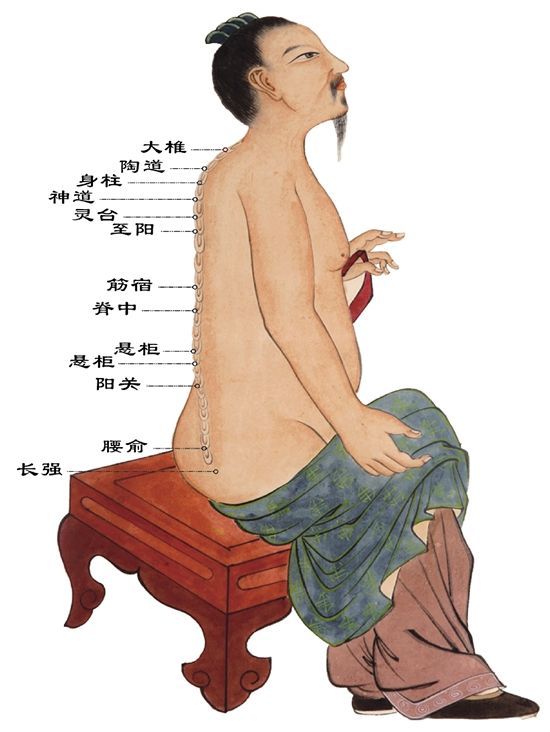
1. Further strengthen the connections between the twelve meridians: for example, the Du Mai governs all Yang meridians; the Ren Mai governs all Yin meridians; the Dai Mai restrains the vertical meridians. The Yin Qiao and Yang Qiao govern the left and right Yin and Yang of the body; the Yin Wei and Yang Wei connect the internal and external Yin and Yang. Thus, the Eight Extraordinary Meridians further enhance the connections among various parts of the body.
2. Regulate the qi and blood of the twelve meridians: when the qi of the twelve meridians is abundant, it is stored in the Eight Extraordinary Meridians; when the qi and blood of the twelve meridians are insufficient, the Eight Extraordinary Meridians can “overflow” to provide timely supplementation.
3. The Eight Extraordinary Meridians have a close relationship with the liver, kidneys, and other organs, as well as with the uterus, brain, and marrow, having certain connections in both physiological and pathological aspects.
Pathways and Physiological Functions of the Eight Extraordinary Meridians
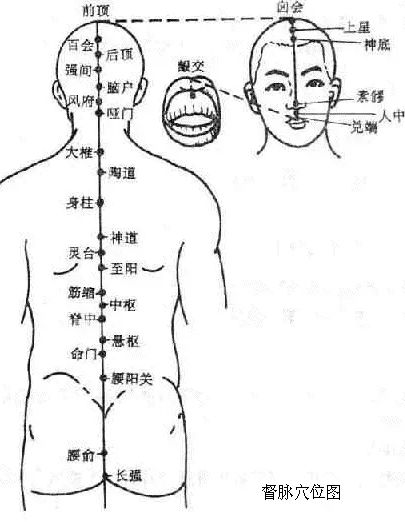
1Pathway and Physiological Functions of the Du Mai
1. Pathway: The Du Mai originates from the lower abdomen, exits at the perineum, travels posteriorly to the Changqiang point at the sacrum, ascends along the spine, passes through the nape to the Fengfu point, enters the brain, belongs to the brain, runs along the midline of the head, ascends to the Baihui point at the crown, descends through the forehead to the Su Liao point at the tip of the nose, passes through the philtrum, and reaches the Gingjiao point at the center of the upper gums.
2. Branches: The first branch, along with the Chong and Ren meridians, originates from the uterus, exits at the perineum, and at the tailbone, it connects with the Kidney meridian and the Bladder meridian. The second branch ascends directly from the lower abdomen through the navel, travels upward to the throat, intersects with the Chong and Ren meridians, and reaches the jaw, encircling the lips and connecting to the center below the eyes. The third branch, originating from the inner canthus of the foot’s Taiyang meridian, ascends to the forehead, converges at the crown, connects to the brain, and then branches down the back of the neck, along the inner scapula, beside the spine, reaching the waist, and enters the muscles on both sides of the spine, connecting with the kidneys.
3. Physiological Functions
(1) Regulates the qi and blood of the Yang meridians, serving as the “Sea of Yang Meridians”: The Du Mai runs along the back, which is Yang, indicating its role in commanding and supervising the qi of all Yang meridians. Additionally, all six Yang meridians intersect with the Du Mai at the Dazhui point, thus the Du Mai has a regulatory function over the Yang meridians, hence the saying “governs all Yang meridians”.
(2) Reflects the functions of the brain, kidneys, and spinal cord: The Du Mai belongs to the brain and connects with the kidneys. The kidneys produce marrow, and the brain is the sea of marrow. The relationship between the Du Mai and the brain, kidneys, and spinal cord is very close.
(3) Governs reproductive functions: The Du Mai connects with the kidneys, which govern reproduction, thus it is related to reproductive functions.
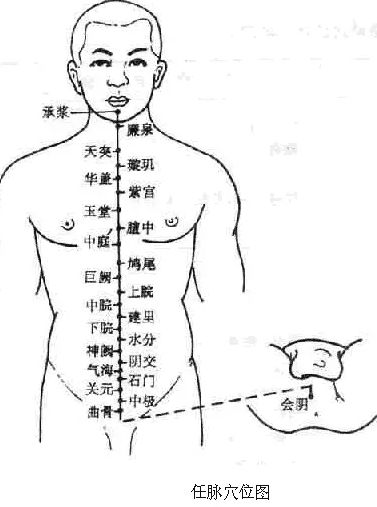
2Pathway and Physiological Functions of the Ren Mai
1. Pathway: The Ren Mai originates from the uterus, exits at the perineum, travels through the Yinfu, ascends along the midline of the abdomen, passes through the throat (Tiantu point), reaches the inner lower lip, divides to encircle the lips, intersects with the Du Mai at the Gingjiao point, and then ascends to the lower eyelids (Chengqi point), connecting with the Yangming meridian.
2. Branches: It traverses the spine from the uterus, ascending along the back.
3. Physiological Functions
(1) Regulates the qi and blood of the Yin meridians, serving as the “Sea of Yin Meridians”: The Ren Mai runs along the midline of the abdomen, which is Yin, indicating its role in overseeing and governing the qi of all Yin meridians. Additionally, the three Yin meridians of the feet intersect with the Ren Mai in the lower abdomen, and the three Yin meridians of the hands connect with the Ren Mai through the three Yin meridians of the feet, thus the Ren Mai has a regulatory function over the Yin meridians, hence the saying “governs all Yin”.
(2) Regulates menstruation and supports fetal development: The Ren Mai originates from the uterus, thus it has the function of regulating menstruation and promoting women’s reproductive functions, hence the saying “Ren governs the uterus”.
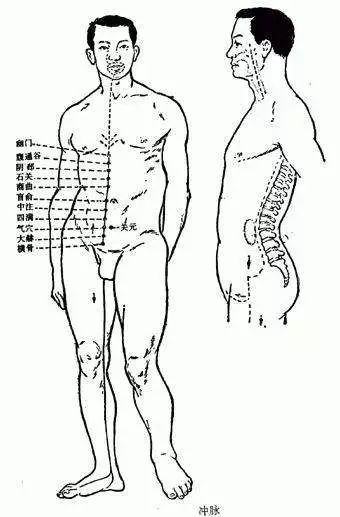
3Pathway and Physiological Functions of the Chong Mai
1. Pathway: The Chong Mai originates from the uterus, exits at the perineum, and divides into two branches. The ascending branch (the main pathway of the Chong Mai) runs along the anterior abdominal wall, near the navel, ascends, connects with the Kidney meridian, spreads in the chest, ascends through the throat, and encircles the lips; the descending branch runs along the posterior abdominal wall, ascending within the spine. The descending branch exits the perineum, travels down the inner thigh to the big toe.
2. Physiological Functions
(1) Regulates the qi and blood of the twelve meridians: The Chong Mai ascends to the head and descends to the feet, traversing the entire body, serving as a crucial junction for the qi and blood of all meridians. When the qi and blood of the meridians and organs are abundant, the Chong Mai can store and accumulate them; when they are insufficient, the Chong Mai can provide infusion and supplementation to maintain the normal physiological activities of the body’s tissues and organs. Thus, it is referred to as the “Sea of the Twelve Meridians”, “Sea of the Five Zang and Six Fu”, and “Blood Sea”.
(2) Governs reproductive functions: The Chong Mai originates from the uterus, also known as the “Blood Chamber” or “Blood Sea”. The Chong Mai has a role in regulating menstruation. It is closely related to reproductive functions; for women, “when the Chong Mai is abundant, menstruation occurs regularly, thus leading to conception”. Conversely, if the Chong Mai is deficient, it can lead to reproductive dysfunction.
(3) Regulates the ascending and descending of qi: The Chong Mai connects with the Kidney meridian, which is associated with the Yangming and Jueyin meridians, thus it has the function of regulating the ascending and descending of qi in certain organs (mainly the liver, kidneys, and stomach).
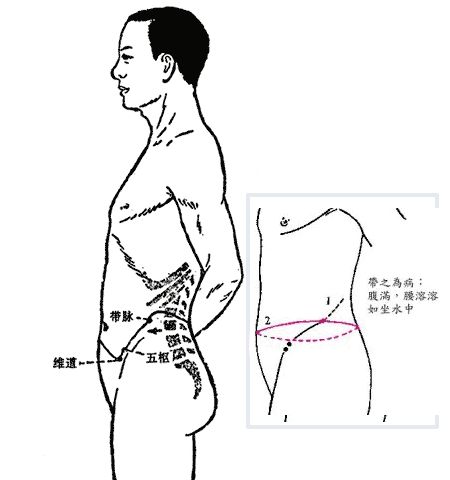
4Pathway and Physiological Functions of the Dai Mai
1. Pathway: The Dai Mai originates from the lateral abdomen, descends obliquely, intersects with the Dai Mai point of the Gallbladder meridian, encircles the body, and then descends obliquely along the upper edge of the hip bone to the lower abdomen.
2. Physiological Functions: It restrains the vertical meridians and governs women’s leukorrhea.

5Pathway and Physiological Functions of the Yin Qiao Mai
1. Pathway: The Yin Qiao Mai originates from the inner side of the heel of the foot’s Shaoyin meridian at the Zhaohai point, ascends through the inner ankle, travels along the inner thigh to the anterior genital area, ascends along the anterior trunk to the chest, enters the throat near the Ren Mai, and reaches the side of the nose, connecting with the inner canthus of the eyes, and ascends along with the Taiyang and Yang Qiao Mai.
2. Physiological Functions: Controls the opening and closing of the eyes and muscle movements.

6Pathway and Physiological Functions of the Yang Qiao Mai
1. Pathway: The Yang Qiao Mai originates from the outer side of the heel of the foot’s Taiyang meridian at the Shenmai point, ascends along the outer ankle, travels up the outer edge of the lower limb to the abdomen, runs along the posterior outer side of the chest, ascends through the shoulder, neck, and reaches the corner of the mouth, arriving at the inner canthus of the eyes. It connects with the Taiyang meridian and the Yin Qiao Mai, then ascends along the Taiyang meridian to meet the Shaoyang meridian at the Fengchi point behind the neck.
2. Physiological Functions: Controls the opening and closing of the eyes and muscle movements.
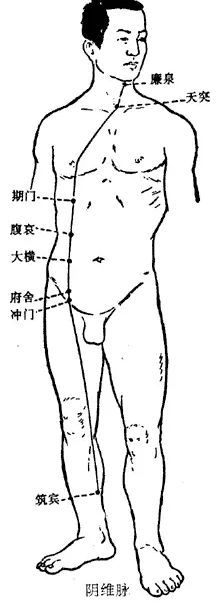
7Pathway and Physiological Functions of the Yin Wei Mai
1. Pathway: The Yin Wei Mai originates from the Zhubin point, five cun above the inner ankle of the foot’s Shaoyin meridian, ascends along the inner side of the lower limb to the abdomen, travels alongside the Taiyin Spleen meridian to the lateral abdomen, connects with the Jueyin Liver meridian, ascends to intersect with the Ren Mai at the Tiantu point, and terminates at the Lianquan point in the throat.
2. Physiological Functions: The “Wei” in Wei Mai implies connection. The Yin Wei Mai has the function of connecting the Yin meridians.

8Pathway and Physiological Functions of the Yang Wei Mai
1. Pathway: The Yang Wei Mai originates from the Jimen point of the foot’s Taiyang meridian, passes over the outer ankle, ascends along the outer edge of the lower limb, travels through the posterior outer side of the trunk, ascends through the shoulder, neck, and reaches the forehead, distributing to the sides of the head and the back of the neck, connecting with the Du Mai.
2. Physiological Functions: Connects the Yang meridians.
The clinical application of the Eight Extraordinary Meridians is a challenging aspect; currently, it is rare for practitioners to proficiently use the twelve meridians for diagnosis, and even fewer are well-versed in the diagnosis of the Eight Extraordinary Meridians. However, many complex and difficult diseases in clinical practice require the use of the Eight Extraordinary Meridians for diagnosis. The clinical value of diagnosing with the Eight Extraordinary Meridians is significant, and it is very meaningful to summarize and explore the rules of medication.
The theory of the Eight Extraordinary Meridians is mainly applied in acupuncture, massage, qigong, health preservation, and Taoist practices, and it is also used to guide medication for treating diseases.
The “Lingshu: Meridian Chapter” briefly categorizes the diagnosis of diseases related to the Eight Extraordinary Meridians into deficiency and excess types. The occurrence of diseases depends on various pathogenic factors, while the development of diseases is based on the strength of the body’s righteous qi and evil qi and their transformation.
From the analysis of the symptoms related to the Eight Extraordinary Meridians, excess conditions are often caused by external pathogenic factors, improper diet, injuries, and phlegm-stasis leading to obstruction of qi and blood in the Eight Extraordinary Meridians; deficiency conditions are mostly due to emotional injuries, congenital insufficiency, acquired imbalances, or chronic diseases leading to the consumption of essence and blood, resulting in the decline of organ functions.
Under certain conditions, it can transform into a mixed deficiency-excess condition. The diseases of the Eight Extraordinary Meridians are discussed in detail in relevant chapters, and here we will simply summarize them for a preliminary understanding.
1. Du Mai Disease
Excess: Pain in the lower back and spine, headache, stiff neck, stroke, opisthotonos, epilepsy, mania, spasms of the limbs, urinary retention, etc.
Deficiency: Heaviness in the head, dizziness, shaking of the head, tremors, stooping, weakness of the limbs, frequent yawning, forgetfulness, low intelligence, etc.
2. Ren Mai Disease
Excess: Pain in the genital area or penis, hematuria, dysentery, hiccups, hernia in men, pelvic masses in women, etc.
Deficiency: Coldness and deficiency of the uterus in women leading to infertility, miscarriage, irregular menstruation, uterine prolapse, etc.; impotence, premature ejaculation, nocturnal emissions in men, etc.
3. Chong Mai Disease
Excess: Pain in the chest and abdomen, gastrointestinal spasms, abdominal distension with qi rising, retention of the placenta, etc.
Deficiency: Irregular menstruation, miscarriage, infertility in women, excessive bleeding, etc.; impotence, oligospermia, infertility in men, etc.
4. Dai Mai Disease
Excess: Pain in the lower back and spine, groin pain, herpes zoster, leukorrhea, etc.
Deficiency: Numbness in the lower limbs, weakness and relaxation of the abdominal muscles, hernia, and excessive leukorrhea in women, etc.
5. Yang Qiao Mai Disease
Excess: Stiffness and pain in the lower back, spasms in the lower limbs, foot eversion, red and painful eyes, headache, etc.
Deficiency: Insomnia, pain in the brow ridge, epilepsy, numbness in the limbs, etc.
6. Yin Qiao Mai Disease
Excess: Epilepsy, spasms in the lower limbs, foot inversion, constipation, lower abdominal pain, etc.
Deficiency: Drowsiness, globus sensation, borborygmi, dribbling urination.
7. Yang Wei Mai Disease
Excess: Chills and fever, swelling and pain in the limbs and joints, headache, red and swollen eyes, etc.
Deficiency: Night sweats, pain in the brow ridge, heat in the palms and soles, numbness, heel pain, coldness in the knees, etc.
8. Yin Wei Mai Disease
Excess: Chest and epigastric fullness and pain, lateral rib pain, herpes zoster, gastroesophageal reflux, etc.
Deficiency: Heart pain, borborygmi, diarrhea, prolapse of the rectum, etc.
Treatment methods: According to the “Shanghan Lun”, the Eight Extraordinary Meridians are not connected to the twelve meridians and have their own pathways. Their diseases are generally related to Yin and Yang, and their treatment methods belong to the twelve meridians.
For example, if the Du Mai is diseased, with stiffness and pain in the back, the pulse should be slightly floating and rapid, and it will feel rough upon palpation, treated as belonging to the Taiyang.
If the Ren Mai is diseased, with internal masses causing pain and hernia, the pulse should be deep and knotty, treated as belonging to the Taiyin.
If the Chong Mai is diseased, with qi rising and urgency in the abdomen, the pulse should be floating, weak, and rapid, treated as belonging to the Taiyin.
If the Dai Mai is diseased, with abdominal pain and cold pain in the waist, the pulse should be deep and thin, treated as belonging to the Shaoyin.
If the Yang Qiao is diseased, with lateral pain and qi flowing outward, the pulse should be taut and rapid, and it will feel relaxed upon palpation, treated as belonging to the Shaoyang.
If the Yin Qiao is diseased, with lateral pain and qi flowing inward, the pulse should be floating and relaxed, and it will feel slightly urgent and taut upon palpation, treated as belonging to the Jueyin.
If the Yang Wei is diseased, with symptoms on the pulse surface, presenting chills and fever, the pulse should be floating and weak, treated as belonging to the Qi level.
If the Yin Wei is diseased, with symptoms in the pulse interior, presenting heart pain and heat in the palms, the pulse should be taut and rough, treated as belonging to the Blood level.
The Yang Wei connects with the Yang, and the Yin Wei connects with the Yin, serving as a distinction between qi and blood, thus not confined to a single meridian.
The diseases of the Eight Extraordinary Meridians arise from various meridians being affected by pathogens, transmitted over time, or caused by overexertion, rather than sudden outbreaks.
Ye believes thatthe Eight Extraordinary Meridians are closely related to the liver and kidneys, “the Eight Meridians are subordinate to the liver and kidneys”, “if the liver and kidneys are weak and unstable, the Eight Meridians will lose their functions”, “if the essence and qi of the liver and kidneys are damaged, the Eight Extraordinary Meridians will lack the strength to function”, “if the liver and kidneys are injured, the Eight Meridians will be deficient in qi”, “if the lower source is depleted, it will inevitably affect the Eight Meridians”. He believes that if the liver and kidneys are damaged for a long time, it will inevitably affect the Eight Extraordinary Meridians. When using the Eight Extraordinary Meridians for diagnosis and treatment,each of the Chong, Ren, Du, and Dai has a main medicinal herb: “for diseases of the Chong Mai, use quartz to calm the counterflow; for diseases of the Ren Mai, use tortoise shell to stabilize; for diseases of the Du Mai, use deer antler to warm; for diseases of the Dai Mai, use Angelica to nourish” (from “Clinical Guidelines for Medical Cases: Postpartum Disorders”). Specific medication is summarized as follows.
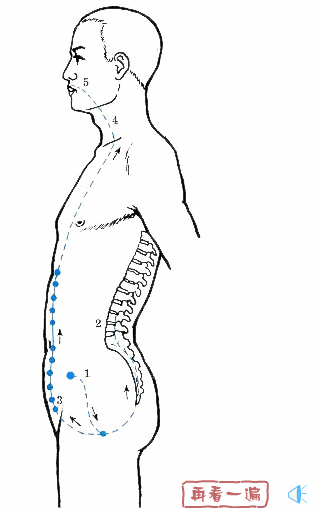
Du Mai
The Du Mai governs all Yang in the body, being the sea of Yang meridians. The relationship between the Du Mai and the liver and kidneys in terms of meridian pathways is very close; if the Du Mai is deficient, it can lead to symptoms such as soreness and heaviness in the lower back.
The treatment for Du Mai disease is in the Shaoyin,
Main herbs: deer antler, deer horn glue, deer horn powder.
Other herbs: cordyceps, lamb, lamb kidney, goji berries, astragalus, psoralea, cooked rehmannia, chives, cuscuta, and spinal marrow from cattle, pigs, and sheep.
Medicinal herbs for opening the meridians: “Ancient practitioners often used to open the collaterals, also entering the extraordinary meridians”. Can be combined with aconite, cinnamon, dried ginger, Sichuan pepper, cinnamon twig, asarum, and ligusticum.
Ren Mai
The Ren Mai is the sea of Yin meridians, serving a nurturing role, and is the “source of life” and “governs the uterus”. Its pathway may connect with the liver and kidney meridians or have commonalities. The symptoms of diseases governed by the Ren Mai, such as “internal masses in men, women’s masses” and “urinary retention”, are similar to those of the Jueyin and Shaoyin.The treatment for Ren Mai disease is in the Jueyin.
Main herb: tortoise shell.
Other herbs: donkey-hide gelatin, tortoise shell, fish gelatin, sea cucumber, clam meat, cordyceps, quartz, mugwort, glehnia, raspberry, etc.
Fire-reducing herbs: The Ren Mai connects with the liver and kidneys, thus treatment of the Ren Mai also requires the use of herbs to reduce kidney fire, such as anemarrhena, phellodendron, scrophularia, and cooked rehmannia.
Chong Mai
The Chong Mai is the sea of blood, and its pathway distribution may connect with the Kidney meridian or its collaterals,treated from both Jueyin and Yangming.
Main herb: quartz (to stabilize the Chong Mai).
Other herbs: cooked rehmannia, goji berries, sha yuan zi, cordyceps, schisandra, red clay, walnut meat, angelica, tortoise shell, cistanche, eucommia, yam, and morinda root.
Qi-regulating herbs: The Chong Mai connects with the liver and stomach, thus it is necessary to combine with herbs that regulate qi and open the collaterals, such as melia, sandalwood, evodia, fennel, poria, and biota seed.
Dai Mai
The Dai Mai serves a restraining function; Ye believes: “the meridian’s qi disperses and does not restrain… it must be guided to gather and stabilize”.
Main herbs: angelica, quartz, yuyuliang, yellow eel glue, sha yuan zi, cuttlefish bone, white peony, cooked rehmannia, goji berries.
Stabilizing herbs: Treatment of the Dai Mai also requires stabilization, thus can be combined with yam, lotus seed, gorgon fruit, jujube, dragon bone, oyster shell, etc.
Wei Mai
Serves a protective function, divided into Yin Wei and Yang Wei. Yang Wei disease presents with cold and heat symptoms, while Yin Wei disease presents with heart pain,treated in the middle jiao.
Commonly used herbs include angelica, cinnamon twig with deer horn powder, sha yuan zi, goji berries, etc., often combined with fennel, biota seed, and poria to open the collaterals.
Qiao Mai
Serves a protective function, divided into Yin Qiao and Yang Qiao. Yang Qiao disease presents with Yin deficiency and Yang excess, while Yin Qiao disease presents with Yang deficiency and Yin excess.treated in the liver and kidneys.
Commonly used herbs include white peony, cornelian cherry, cooked rehmannia, tortoise shell, sea cucumber, wheat, jujube, roasted licorice, and schisandra, or half summer with rice soup.
Previous Articles:
-
Illustrated Guide to the Twelve Meridians and Their Corresponding Herbs [Recommended for Collection and Study]
-
Human Meridian Diagram (Exquisite 3D Dynamic Pathway Diagram)
-
Classic Mnemonics for the Twelve Meridians
-
A Unique Folk Method: New Five Elements Treatment for Major Illnesses, Nineteen An Points for Effective Use
-
20 Folk TCM Diagnostic Tips, Master Them and You Become a Guru
-
Why Are Rolling Massage Sticks So Popular?

